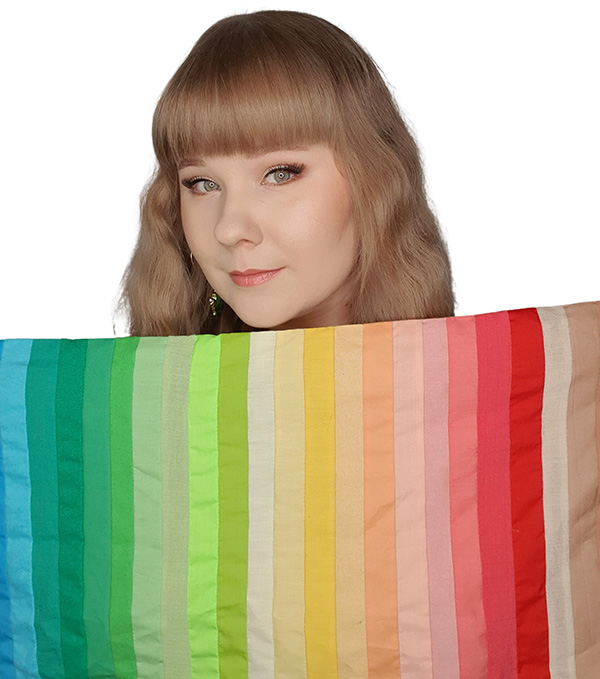What is colour analysis?
Colour analysis is a method that can be used to find your best colours by comparing the reactions of your skin to different fabrics or calibrated digital colour backgrounds. The roots of colour analysis lead back to the 18th century and painted art. Later, in the 19th century, different colour analysis methods were developed. Most of the colour analysis methods include 4 or 12 seasons. I have been trained to a method that has 16 seasons in total.
Colour analysis is based on the qualities of your colouring that are determined by your genes. These are your skin undertone and the value and intensity of your colouring. Your skin undertone can be warm, neutral, neutral-warm, neutral-cool or cool. A fully neutral undertone is rare and usually the skin undertone is leaning slightly warm or cool. Value range varies from light to medium to deep and intensity range varies from low (soft and muted) to medium to high (bright and vivid). Because these qualities are determined by genes, changing your hair colour doesn’t change your season. What it can do is to change your preferences about colours that suit you best. Colour analysis isn´t about preferences but instead about finding colours that harmonize with you the most. Your best colours have the same undertone, value and intensity as you, so they are in harmony with your colouring.
The colour analysis of 16 seasons includes four main seasons. These are true spring, true summer, true autumn and true winter. Furthermore, there are 12 flow seasons that are in a way a mix of two true seasons and a season midway those two true seasons. These flow seasons are called light spring, warm spring, bright spring, light summer, soft summer, cool summer, warm autumn, soft autumn, deep autumn, bright winter, cool winter and deep winter.
Colour analysis is for everyone regardless of your age or gender. Once correctly performed, your colour analysis result does not change, since your skin undertone does not change. You can adapt your colour analysis results to clothing, cosmetics, hair colour, jewelry and other accessories and even to interior design.

How much does it cost to get a colour analysis?
Digital colour analysis with a digital colour palette costs 150€. Digital colour analysis with a digital colour palette and a colour swatch wallet costs 190€. Follow Colourful Harmony on Instagram or on Facebook to be the first to know when our products and services are on sale or when we launch something new!
What is the most reliable method to do colour analysis, and is it possible to do digitally?
It depends on the training of the colour analyst. You cannot do a digital colour analysis with every colour analysis method because there are no calibrated digital tools in every method. It is, though, incorrect that you cannot do a digital colour analysis reliably at all. I use the advanced colour analysis method that has 16 seasons and there are calibrated colour backgrounds that are designed to be used in this method. I also have been trained to use these colour backgrounds.
Why should I get my colours done?
In colour analysis you get to know the colours that suit you best and are in harmony with you. This helps you to limit the time and money you use in buying clothing. It is also likely that you find new colours that you hadn’t even thought about trying. You will also get recommendations for your best hair and makeup colours. Your best colours make your skin look smoother and healthier. So called wrong colours will emphasize shadows on your skin and unevenness of the skin, bring redness or sallowness and take off the glow of your skin.
Can I do colour analysis myself?
If you aren’t a trained colour consultant but you are interested in colour analysis, I recommend that you invest in yourself and get your colours done by a professional to get a reliable result. When trying to do colour analysis yourself without proper training, the analysis is often guided by preconceptions, your likes and dislikes and the emotions evoked by different colours. You are also likely to match the colours with the overtone of your skin, although it is the undertone that really matters in colour analysis. For example, the redness on the skin may lead you in the wrong direction if that is automatically thought to be a sign of a cool skin undertone.
What if my favourite colour is not in my colour palette?
You are free to use whatever colours you want. The most important thing regarding colours, in my opinion, is that the way you are using them makes you happy. Colour analysis is a tool to help you find your best colours, get more use out of colours, and hopefully find new favourite colours. You will find most of the colours in every colour palette but there are different versions of the colours in the palettes. For example, you will find greens, yellows, blues and reds in every colour palette. There are, however, a few exceptions, like black. You can only find black in colour palettes that have winter in them. When getting your colours done with me, I will also give you tips and tricks how to minimize the effect that the nonideal colours may give you.


